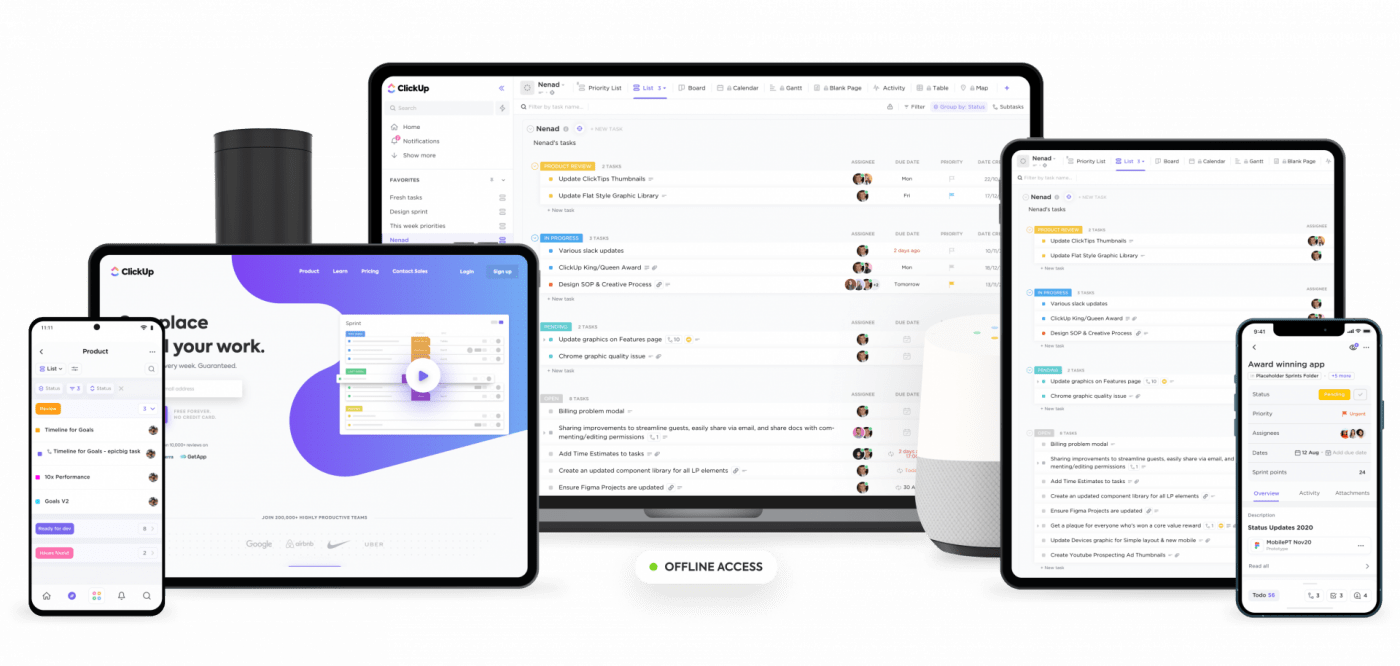

Want to learn about SDLC Agile?
Sounds like something complicated from a boring project management class, doesn’t it?
But don’t worry.
SDLC Agile is actually quite fun to learn and not all that difficult.
In fact, anyone can ace it after going through this article.

We’ll cover what the Agile software development lifecycle is and how it’s different from traditional SDLC. We’ll also show you how to manage any Agile project efficiently.
Let’s get started!
What Is SDLC?
SDLC is simply the acronym for Software Development Life Cycle. It consists of all the steps that go into building and maintaining any software.
Like most SDLC models, the Agile model also follows the basic steps of the SDLC, with some variations. So first, let’s understand what goes into an SDLC model before learning the “Agile magic”.
In most SDLC models, the development cycle goes through phases like:
- Requirement analysis: plan what the users want and how to cater to them
- Design: design the framework of the system to be built
- Coding and developing: build the system by programming
- Testing: check the system for any bugs or errors
- Deployment: launch the system to the users
- Maintenance: keep the system up and running smoothly
Sounds pretty extensive, right?
Pretty much like preparing a super-delicious dish, software needs to go through various SDLC stages to get to its final form.

Let’s now have a quick look at what goes into each stage of a development lifecycle model:
Stage 1: Requirement gathering and analysis
The goal of any software is to address a specific problem or need the user has.
In this stage of the software development process, the project manager meets with the stakeholder or users to understand their requirements.
The goal is to answer questions like:
- Who will use the software?
- How will they use the software?
- What would the software need as input?
- What would the software give out as output?
After the meeting, each requirement is analyzed for practicality and feasibility.
Stage 2: Design
You now have an idea of what the stakeholder wants.
So the next step is to create the plans and framework for your software project.
For example, let’s say your project team is working on building a company’s website from scratch.
In the design stage, the team plans things like:
- The layout of the website across various devices like mobile, tab, and desktop
- Colour scheme of the entire website according to the brand
- What programming languages they should use
- Backend frameworks and system server designs
The goal of this step is to create the base of the software architecture for your team to work on.
Stage 3: Coding and developing
The developing stage generally takes the most amount of time and work.
But that’s where the real fun begins!
Here’s what you can expect to happen at this level:
- The development team starts building code
- The operation team sets up the physical hardware and configures the servers
- The designers focus on enhancing the user interface
- The testers analyze the requirements and start designing test plans
However, the software developer gets the spotlight here as they do most of the work!
Stage 4: Testing
Software testing is definitely one of the most important phases of the SDLC methodology.
Here’s an example to help you understand why:
Let’s say the developers have finished building the website.
However, there’s a small bug: when a user logs out, it doesn’t clear the browser session.
So if another person uses the same computer, they could refresh the website and log in to the first user’s account.
It would be a huge headache if this was deployed, right?

That’s why you test the software for bugs or errors before deploying it.
Let’s see how the testers work their magic in the software testing phase:
- Brainstorm on all possible test parameters and use cases according to the developed feature/requirement
- Incorporate them to create a 360-degree test plan that can detect all bugs
- Run all the planned tests
Once they spot any bugs or undefined behavior, it goes straight back to the software developer for fixing.
Learn more about agile testing.
Stage 5: Deployment
With all (or most of) the bugs smashed, your website is ready to be deployed.
The operation team now eagerly works on getting it live and running smoothly.
To deploy the software, they would need to take care of things like:
- Getting all the servers, software, and other hardware up and running for the release
- Setting up the links and databases to ensure everything is ready
However, before the final deployment, another round of quality assurance (beta testing/user acceptance testing) is generally done.
What happens in this testing?
You give the software to some customers to check for additional bugs or usability issues. If there’s an issue, the software development team fixes it before the final deployment.
And while getting a product shipped out is a big accomplishment, you probably won’t get a ribbon-cutting ceremony to celebrate it!

Stage 6: Maintenance
You can’t just release the software and forget about it, right?
Unless you want your company’s inbox filled with comments from angry customers!
When any system is deployed in the real world, bugs naturally pop up from time to time. Your development team would need to make patches for it.
You would also get some feedback from your customers regarding things like usability, practicality, or improvement ideas, which you can decide to incorporate.
For any cloud-based systems (website, software, or app), the operation team has another important role in this SDLC process stage. They ensure that the server software stays updated and its hardware can handle the load.
For example, if your users increase by 30,000 over a timeframe of six months, you’d most likely need to add more servers to ensure that your system runs smoothly.
And with that, we’ve finished the SDLC process!
But wait… how does the SDLC model change in Agile development?
To know that, you should have a clear idea of the Agile framework first.
For those who are already clear about the Agile process, click here to jump straight to the Agile SDLC model.
What Is Agile?
Agile is a broad project management methodology that focuses on involving the customer in every step of the development process.
How does it do that?
The Agile approach breaks down the entire project into smaller development cycles called iterations or sprints.
In the Agile methodology, for every iteration, you develop a specific version of the working software. This is called the increment.
At the end of the iteration, the customer reviews the increment and gives their feedback, which is incorporated in the next iteration. The cycle continues until the software is fully developed, giving the customers exactly what they want.
Here’s an example of a real-life software development process to make things crystal clear:
Let’s say you’re developing a new dating app using the traditional Waterfall model.
Your project team would normally spend a year on releasing the app.
But one month after launching the app, you find out that most of your users don’t like those “cute” photo filters that your team spent two months developing!

Heartbreaking, isn’t it?
All that time and money, along with your team’s sanity, have gone out the window!
However, things would be different if you had used the Agile approach.
In Agile development, at the end of each iterative process (which lasts about 2-4 weeks), you get feedback from your customers about your latest increment. This way, using the Agile method, you can scrap a bad feature without wasting time and money for developing it.
The best part?
With the Agile method, your software will be exactly how your customers would need it to be.
Learn how to implement Agile workflows 💜
The SDLC Agile Model
Let’s now answer the bugging question:
What does a software development lifecycle in the Agile framework look like?
Short answer: the development process and the model stays the same.
However, the execution becomes iterative and incremental, following the Agile practices, as mentioned in the Agile manifesto.
What does that mean?
- Iterative: the cycle is repeated until you get the desired result
- Incremental: every cycle has something more advanced to offer (the increment)
The Agile SDLC model is executed and repeated at every iteration (generally, the entire software development lifecycle lasts for only about a month) until you get the final product.
Remember, in Agile software development, the stakeholder comes in at the end of each iteration and gives their feedback. This is then incorporated in the requirement analysis stage of the next software development iteration.
So here’s how the SDLC stages change in the Agile SDLC model:
- Requirement analysis: incorporates the suggestions received at the end of the previous iteration
- Design: the feedback is kept in mind while designing the upcoming increment
- Coding and developing: the developers work to build the increment (which includes only some features) rather than building the entire software in one go
- Testing: the testers design and execute test plans according to the increment
- Deployment: the operation team deploys the newly developed version
- Maintenance: the new software version is monitored by the operation team to ensure things are working smoothly before starting on the next iteration
Note that in the Agile software development lifecycle, after the deployment, the customer interaction and feedback is necessary before starting the next cycle.
Still not completely clear about the differences between the Agile development model and the traditional SDLC model?
Don’t worry. We have more in store for you!
Agile Vs. Traditional SDLC Models
Generally, when people say SDLC, they refer to the traditional Waterfall SDLC model.
So how does the SDLC model differ between the Agile and the Waterfall methodology?
Short answer: the Agile model is flexible and adaptable.

In the traditional Waterfall model, customer interaction or feedback isn’t available. So, the team spends a lot of time in the requirement analysis stage, assuming what the users would need.
Once they decide the features to build and work on, that stays as a clear goal throughout the project and can’t be changed at any later stage. The software development lifecycle would go on normally for a year or until the software is ready and finally deployed.
However, for Agile SDLC, the Agile team doesn’t spend much time on the requirement phase since they know it’s flexible and can revisit it anytime in the future.
Here’s a quick chart summarizing these differences:
| Agile SDLC model | Traditional SDLC model | |
| Flexibility | Very flexible and can swiftly adapt the project according to user needs and demands | Inflexible, major changes are welcome only at the initial stages of the project |
| Iteration cycles | Uses as many iterations as needed, each lasting around 2-4 weeks | Takes on the entire project in one long cycle |
| Approach | Takes an iterative approach | Uses a linear approach |
| Documentation | Has minimum documentation | Has intensive documentation |
| Project size | Suitable for all project sizes due to its adaptability | Suitable for smaller projects as the margin of error is smaller |
| Planning | Minimal planning is required in initial stages as changes can be made later on | Intensive planning processes is required before the development process starts |
| Deliverability | A partially working product is delivered at the end of an iteration | The working product is only available towards the end of the software development process |
So, which model is right for your business?
Let’s take a look at the pros and cons of each SDLC model so you can decide for yourself.
Here are some reasons to consider using a traditional model like the Waterfall model:
- Easy to understand and implement
- Easily manageable due to rigidity of its structure
- Goals and milestones are crystal clear
Some flaws of the conventional SDLC methodology include:
- High-risk factor due to lack of flexibility and adaptability
- Not suitable for large, complex software development projects
- No working software is available until the later end of the software development life cycle
Now, let’s look at some advantages of the Agile software development model:
- Minimal risk factor due to high flexibility and adaptability
- Delivers partially working software throughout the development cycle
- Promotes better teamwork (self-organization and cross-functionality)
Some drawbacks of the Agile software development model are:
- Meeting the deadlines can be challenging since the entire cycle is short
- Scope creep can become a problem
However, with efficient project management practices, you can overcome all these challenges!
Let’s take a closer look at how:
How to Manage Agile Software Development Cycle Effectively
Managing a project can be challenging, especially when it’s something like a fast-changing Agile SDLC.
I mean, you have targets, team roles, goals, and a lot of fast-moving parts.
Luckily, you don’t have to be a lightning-quick superhero to manage SDLC Agile.

All you need is a powerful software like ClickUp, which makes managing the Agile lifecycle a walk in the park.
Wait, what’s ClickUp?

ClickUp is the world’s highest-rated Agile project management software.
Whether you need help with:
- Any methodology like Kanban, Agile Scrum, or Extreme Programming
- Managing your product backlog or sprint backlog
- Keeping track of your testing processes like bug testing or security testing
- Any planning process, like sprint planning or resource planning
ClickUp has got you covered!
Sounds great?
Let’s take a look at how ClickUp can help you through the entire software development process:
A. Goals
Goals are super important for every project.
Without it, your project will be like a lost ship in the middle of the ocean.
Just before starting the first iteration of the software lifecycle, you’ll need to set both long term and short term goals for your Agile project.
Here’s what goals look like in the Agile methodology:
- Optimize landing page design for maximum customer interaction
- Add a timer feature to the landing page
- Add a popup feature when the user goes to exit the webpage
Usually, at every requirement analysis stage, you often get multiple goals to take care of.
But how do you keep track of every goal?
Keeping track of everything on a piece of paper is certainly not a good option in 2022.
Who knows what can happen to that sheet of paper?!

Luckily, ClickUp’s Goals feature can help you out!
Goals are high-level containers that can be broken down into smaller Targets, which can be easier to achieve. While this keeps everything organized, it also motivates your Agile or Scrum team by giving them a frequent feeling of accomplishment.
Additionally, with every completed Target, ClickUp auto-updates your team’s progress percentage in real-time. This way, everyone has a clear picture of how close they are to achieving the goal.
Using ClickUp’s Goals, you can also:
- Quantify your Agile Goals with OKRs (Objectives and Key Results)
- Create weekly scorecards for better performance appraisal
- Track Scrum sprints or any project in real-time

B. Workflow Automation
ClickUp’s Automation feature lets you automate repetitive, tedious tasks by offering tons of task automations. This saves you time and frees up your useful resources for tasks that actually need them.
Here’s how the workflow Automation actually works:
If a trigger happens and a condition is true, a specific action is executed automatically.
Kinda like:
If a game is launched and your gamers are happy, the champagne pops automatically.
With ClickUp, you can create a customized automation for your Agile model workflows.
However, you can also get started instantly with ClickUp’s 50+ prebuilt Automations.
Here are some useful Automations to help you manage the Agile software development lifecycle process:
- Change the assignee automatically when a task’s status changes
- Apply a template to save time while creating a task
- Update task priority automatically when its checklist is cleared
- Change tags automatically when a task’s deadline arrives
- Archive a task when its priority is changed
(Click here to check out more preset Automations.)

C. Multiple Views
Whether it’s software development or navigating a ship, getting a good view of things helps!
With ClickUp’s Multiple Views, you can get perfect overviews of what your team members are dealing with at any stage of the SDLC model.
Here are the types of views available in ClickUp:
- List view: great for teams who prefer viewing their Dashboard as GTD-style to-do lists
- Board view: visualize tasks on your Dashboard in Kanban style
- Calendar view: plan and manage your project schedule on a calendar
- Box view: view tasks sorted by assignee to instantly know who is working on what
- Me Mode: show tasks that are only assigned to you

How to use these Views?
For example, a project manager or Scrum master can use the Box view to check if the team’s being overworked. All it takes is a single glance!
Additionally, when you need to plan a Scrum meeting, you can quickly switch to the Calendar view in a single click.
D. Dashboards
A captain should never lose sight of everything that’s going around them.
We all remember Titanic, right?

Similarly, a project manager must have a clear idea of everything that’s going in every step of the software development life cycle.
With ClickUp’s Dashboard, that’s exactly what you’ll get!
Dashboards give you high-level visual charts of your entire project. You can monitor them and ensure everything is running smoothly.
Using customizable sprint widgets, you can add multiple graphs to your Dashboard, like:
- Velocity Charts: display the completion rate for any set of tasks
- Burndown Charts: forecast the amount of work remaining in the project
- Burnup Charts: reveals the amount of work already completed in a project
- Cumulative Flow Charts: presents you the task progress over time

E. Custom Task Statuses
You can’t call up your employees 24/7 and ask them for project updates.
Not only will it affect their productivity, but it’ll also really annoy them.

With ClickUp, you’ll never need to ask for a status update.
Sounds great, but how?
With ClickUp’s Custom Statuses, you can quickly view the status of any task whenever you need to.
But the best part is that you can customize these statuses according to relevant project terms.
For example, in the software testing stage, instead of using a task like “in progress”, you can use something relevant like “beta testing in progress”.

But wait, this was just the tip of the iceberg. Literally.
ClickUp offers a lot more useful features to make every project manager’s life easier.
Here are a few more things this Agile project management tool can help you with:
- Priorities: prioritize your Agile project tasks based on their urgency
- Reporting: access detailed reports on your team’s performance
- Pulse: know which tasks your project team is most active during the day
- Dependencies: approach your tasks in the right order
- Native Time Tracking: track your team’s productive hours without having to leave the ClickUp platform
- Assigned Comments: create action items out of comments to make sure they don’t go unnoticed
- Powerful Mobile Apps: monitor your work on the go with ClickUp’s Android and iOS apps
- Custom Access Rights: follow the Agile principle of involving your customers without compromising any sensitive project information
Conclusion
Unlike the Waterfall approach, the Agile approach takes an iterative and incremental strategy to the SDLC methodology.
The result?
Better products and happier customers!
However, managing software projects while keeping an eye on your Agile team is no joke.
That’s why you need to be fully equipped for it with powerful Agile software like ClickUp.
Whether you need help managing the Agile model or any traditional SDLC model, ClickUp has got you covered!
Click on the captain to sign up with ClickUp and sail through your software development lifecycle easily!




